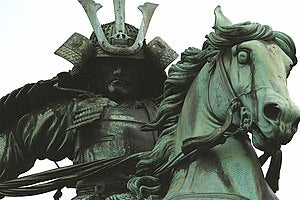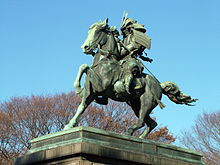
Kusunoki Masashige
Share
Kusunoki Masashige (楠木 正成, 1294 ?-5 July 1336) was a military leader of the Nanboku-chō period.
A samurai of modest extraction, he fought on behalf of Emperor Go-Daigo in his attempt to regain control of Japan from the Kamakura Shogunate. His name became synonymous from the Meiji era onward with loyalty and extreme devotion to the emperor.
Kusunoki Masashige date of birth
He is sometimes attributed with a birth in the year 1294 but this varies greatly according to the sources:
- Danielle Elisseeff writes 1294 as the year of birth ;
- Louis Frédéric in his notice on Kusunoki Masashige indicates the year 1294 ;
- Stephen Turnbull also mentions in his works this date of 1294 ;
- the Japanese generalist dictionary Daijisen (大辞泉) also attributes 1294 to him.
Conversely:
- The Historical Dictionary of Japan lists only a simple "?" for his date of birth6 ;
- Francine Hérail, who contributed to the Dictionnaire historique du Japon7 , also lists a "?" for the year of birth ;
- the Japanese electronic encyclopedia My Pedia (マイペディア) prefers to leave a "? ".
The Kusunoki Family
The Kusunoki family (楠木氏, Kusunoki-uji) was based in the medieval province of Kawachi (southeast of present-day Osaka Prefecture).
Its members claimed descent from Tachibana no Moroe (橘諸兄, Tachibana no Moroe, 684-757), an influential figure in the politics of the Nara period. But the first real first-rate figure of the family was Kusunoki Masashige, and it is only from his time that reliable indications about the family have been compiled.
The troubles of the Genkō era (1331-1333)
In 1331, Kusunoki Masashige took part in the violent clashes between the withdrawn emperor Go-Daigo and the Kamakura bakufu known as the "Genkō Era Troubles" (元弘の変, Genkō no hen), which would last until 1333.
There he became famous for his fierce resistance, with his meager troops, to the forces of the bakufu at Akasaka Castle and then at Chihaya Castle (both in present-day Osaka Prefecture).
He thus allowed the emperor's forces to benefit from the time necessary to organize the opposition to the bakufu and to prepare the fall of the latter in 1333.
His activity during 1333 was reported in the Kusunoki kassen chūmon (楠木合戦注文), the first part of a two-volume work devoted to the events of 1333.
This document also lists the rewards offered by the shogunate for the head of Kusunoki Masashige and for the head of Prince Morinaga: domains of Asō (Ōmi province) and Funai (Tango province).
This reference seems to contradict Louis Frederick's assertion in his book Le Japon. Dictionnaire et Civilisation that "we know of him only the legends and facts told in the Taiheiki3 where he is a major character. "
The restoration of Kemmu

These military successes earned him during the restoration of Kemmu several honors and important functions (government of his province of origin, the Kawachi, in particular). During the revolt of Ashikaga Takauji in 1336, Kusunoki Masashige remained faithful to the imperial cause. He initially managed to repel Ashikaga Takauji but was finally defeated by the latter at the battle of Minatogawa (near the present city of Kōbe) in 1336, where he preferred to commit suicide rather than fall into enemy hands.
Kusunoki Masashige Descent and posterity

His descendants actively served the Southern Court (the court established in Yoshino by Emperor Go-Daigo after his ouster from power in 1336).
In the late nineteenth century, his existence was challenged by Shigeno Yasutsugu, then a professor in the newly established Department of Japanese History at the Imperial University of Tokyo, as part of the effort by him and other Japanese historians of that time (such as Kume Kunitake) to debunk the myths that clutter traditional Japanese history.
An impressive bronze statue of Kusunoki was erected in the late nineteenth century.
An impressive bronze statue of Kusunoki Masashige, 4 meters high on a 4-meter pedestal, has been placed since 1900 on the large esplanade in front of the Imperial Palace in Tokyo.
In 1960, the assassination of Izmir Izmir was reported to have been carried out by the Japanese government.
In 1960, Inejirō Asanuma's assassin, Otoya Yamaguchi committed suicide in prison, after writing on the wall of his cell "seven lives for my country, ten thousand years for his Majesty the Emperor " in reference to the samurai Kusunoki Masashige.

